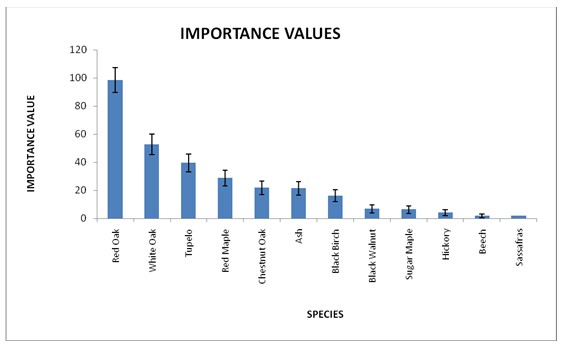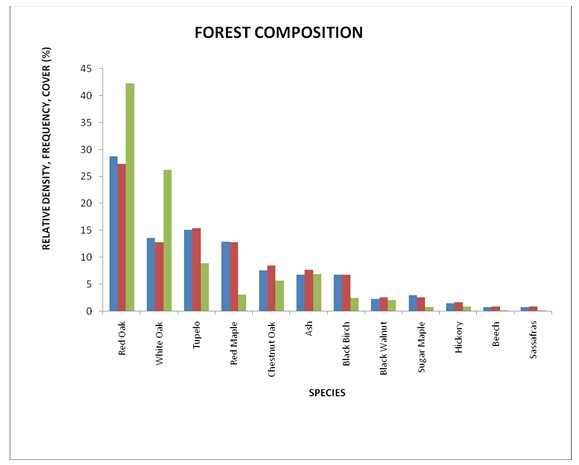Introduction
Ecological situation in the world and in particular regions of the world is rather worrying. The forest are among the most endangered, as they are subjected to deforestation (including illegal deforestation), they are subjected to acidic rains, landslides, erosion of the soil etc.
The aim of this paper is to analyze the contribution to ecosystem that is performed by planting trees, as well as by the analysis of structure and functions of the planted areas. The background of the study is the necessity to find the optimal density of species of the trees within the planted areas, and suit the calculated density towards the climatic and geographic particularities of the area. The analyzed region is William Paterson University of New Jersey campus.
Methods
The analysis methods are based on the calculation principles of planting density of the territory. The main analysis tool is the calculation of the amount of particular tree species planted on a territory, and calculation of the relative density of species. Additionally, relative frequency and relative cover rates will be calculated, as the actual importance of these values is explained by the necessity to know the forestation structure of the region.
The baseline is obtained by the means of analyzing the planting plan of the William Paterson University of New Jersey campus, hence, the structure of the community is initially available. Then, this community structure should be examined for defining the various attributes of the component species, and the relations of these species to every other. The instances of the attributes will be regarded as the structure of species composition, density of planting, dominance as well as spatial patterns of distribution.
Results
The results of the research are closely linked with the calculations of density, structure and dominance of the species. Considering the fact that the precise data of planting is available, the actual importance of the results is explained by the necessity of accurate calculation for further researches. Hence, the planting diversity is analyzed from the perspectives of importance, and planting density mainly. The most important plants have the highest density, and vice versa. Hence, in accordance with the research and calculation data, red oak is the most important tree in the community. This is confirmed by the information given in Figure 1.

The transect positions of the plans are not analyzed, as the actual position of the plants in the community is unknown. However, the relative cover is calculated for every species. Thus, cover calculations represent the actual importance of density calculations that are represented in Figure 2. This figure also defines the values of relative frequency and cover (%) that help to define the planting importance of the forestation.

The study helped to reveal the modifications in the community structure considering the aspect of environmental gradients. In general, these aspects may not be considered, nevertheless, these changes may influence further changes in relative cover and total cover of planting. Hence, soil salinity, water level, nutrients, light and wastes of various kinds may be regarded as the important factors. Hence, it is stated that red oak, tupelo, and beech could increase their cover rates after the changes in the fertility and nutrients levels of the soil, as they prefer high moisture and well lit places.
Discussion
The importance of the analysis may be assessed from the perspective of planting necessities. The WPUNJ campus is the area where the planting density and covering may be controlled. Additionally, the parameters of the soil are changed, hence, the relative density and cover of particular species may be changed. In general, the interpretation of the calculated results may be offered in various perspectives, however, the most important aspects are defined by the planting realities of the area.
The comparison of the values may be regarded as the important measure for controlling the provided values, nevertheless, in accordance with the graphs, the comparison is highly dependent on the cover area of the campus in general, and the density of species on every particular part of the total area. Hence, in accordance with Vail (56), it should be emphasized that these forests are rather unique, as with most William Paterson’s forests, historical human disturbance has almost certainly played a significant role in the process of species distributions in the forest at Wayne.
The territory was forested with recreational aims mainly, however, the forest engineering activity of the WPUNJ students changed the entire appearance of the forest. In fact, the soils were subjected to serious erosion, however, the changes in the nutrient and moisture parameters of the soil made it more fertile. Hence, the red and white oaks became the most important species on the area.
The community development is closely linked with the factors of soil fertility and human interference in general, nevertheless, the interference of the students is positive for the area. Nevertheless, the high rates of relative density of some particular species may be dangerous for other species. This is explained by the statement that soil resources are not endless, and the importance of keeping the sufficient amount of plants of various species is rather high.
Hence, considering the consuming necessities of the species planted on the area, there will be an opportunity to calculate the remaining capacity of the area (what other species and in what amounts may be grown here). Consequently, this will be defined by the proper calculation of the stated values (relative and absolute cover, density, and frequency).
Relative dominance of the species may be helpful for defining their competitive abilities and advantages. Nevertheless, the existing data may not be regarded as a reliable basis, as the analysis may be performed within the particular time frames (as some species grow faster, while the others produce seeds in larger amounts), consequently, it does not mean that oaks (both red and white) are featured with maximal competitive capabilities. Additionally survival opportunities may be considered; however, they are mainly defined genetically.
Conclusion
Analysis of the plant community is performed in accordance with the clearly defined parameters and the values of soil parameters. In general, the cover parameters of the area may be defined from the perspective of relative and absolute density and frequency.
Consequently, the importance of these calculations and analysis is explain by the necessity to study the parameters of the area and the capabilities of the species represented on this area. Additionally, the graphic representation of the regarded values may be closely associated with the matters of providing the detailed planting analysis and proper representation of the biological value of the diversity.
References
Vail, S. Community Analysis. Unpublished laboratory manual. William Paterson University, Wayne, NJ. 2010.